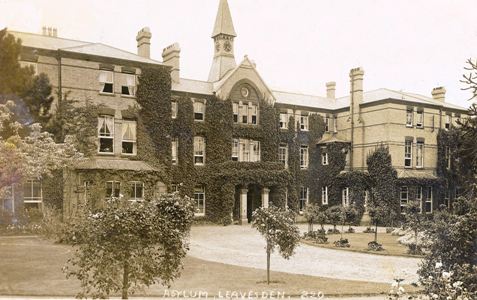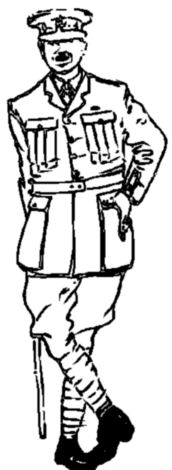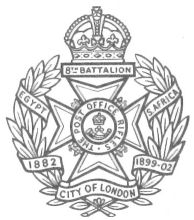|
Post Office Rifles, Leavesden Asylum, Nov. 1914 to March 1915 |
Phil Draper (philandrew1 @t hotmail.com) of Okehampton, Devon, writes: I am looking for information about Arthur Edward Draper (376869) of the Post Office Rifles. He died 1917 at Aldershot as a lance corporal bomber. I understand that the Post Office Rifles stayed at Leavesden lunatic asylum, possibly from November 1914 to March 1915. Would there be any photographs?
 |
The Asylum, Leavesden Card posted Kings Langley on 16th March 1915 to Mrs Skinner, The Laurels, Dalmer Road, Enfield, MDX. Have just sent a parcel off with a few dirty things in. Received the cash alright. Thanks very much. We go from here early tomorrow morning for So'ton. Will write again as soon as poss. love Arthur. |
|
|
It seems very likely that Arthur Skinner was the Arthur Skinner (born 1892, at Walwoth, London) who was a Sorting Clerk & Telegraphist (presumably for the Post Office) living with his parents at 11 Falmer Road, Enfield in 1911. As he sent a card showing the Asylum it is likely he was billeted there with the Post Office Rifles. |
||
You don't say what success you have had tracing Arthur Edward Skinner's military records, and that is outside the scope of this site. When I was collecting material for the book The London Gunners come to Town I discovered that there were very few surviving Hertfordshire records relating to the billeting of troops in the area. In Hemel Hempstead it was very difficult to discover where individual units were billeted, as neither the Council records or the relevant Army War Diaries and other records have survived. I am pretty sure that the same applies to other towns in Hertfordshire - although I have heard of one document that related to the billeting of troops in one short length of one road in Tring.
Quite a lot of my information came from newspaper articles which reported on social events such as a concert. Officers might occasionally be mentions - and lower ranks might be named if, for example, they appeared before the local magistrate. The chance of there being any reference to a particular named soldier in the surviving Hertfordshire records is so low it is not worth looking. Some of the most useful information I got was found by looking at surviving private war diaries, letters home, etc. where the person who wrote the diary was in the same unit as the person you are interested in - and even here you have to be very lucky. These source might not name the person you are looking for but will tell you the kinds of things they might have been doing.
One of the useful sources I found in the Imperial War Museum were letters written by Captain H. Peel to his wife from the Leavesden Asylum and I quote the relevant sections from The London Gunners come to Town:
From Chapter 17: Training at Hemel Hempstead
Of course the officers got the best accommodation and many of the men would have, at least initially, bedded down on straw in barns. However other accommodation was available and in November Captain H. Peel[1] wrote to his wife:
My Darling, I haven’t had a moment to write before. We are more or less settled down here now - we are in the [Leavesden] lunatic asylum! That is to say my company and one other are billeted in the big Recreation Hall of the huge asylum here and we officers are billeted on the superintendent Doctor [Elkins]. All around us are 2,200 incurable lunatics - a most cheerful atmosphere. I’ve been round with the Doctor looking at them this afternoon, and anything more depressing cannot be imagined. Really, the billet is quite a good one and we are very comfortable and well fed and looked after.
[1] From letter by Captain Peel in Imperial War Museum. He was in the Post Office Rifles (8th Battalion) which replaced the London Scottish who had, by this time, been sent to France.
From Chapter 18: Military Events and Excursions
On Boxing Day there were significant movements of infantry in the area, including marches along the London Road through Apsley and Boxmoor. This had a damping effect on the festivities, as Captain H. Peel, of the 1/8th Battalion the Post Office Rifles, describes in a letter he sent to his wife[1]
28th December, 1914: ... We’ve had an appalling Xmas, but the shows were a great success and the men and their families really enjoyed them. It has been a dreadful week and in the middle of the Xmas day performance a note was passed round that an alarm entrainment was to be practised next day and all officers were wanted for a discussion after the show. The show ended up with a mime, the whole of which was written the day before by Clarke and myself. It went very well. We then had our discussion over supper and got to bed at 2 a.m. At 4 a.m. the alarm sounded, we had to see that everything was packed up, etc., and at 6 o’clock my company, and three others, set out [from Leavesden] for Berkhamsted 9 miles away. We marched there in 2˝ hours along London Road through Apsley & Boxmoor and back in 3˝ hours, with a halt of about 10 minutes there. 18 miles in 6 hours in pelting rain and hail and on road so slippery that it was really hard to stand up. It was a bit of a business keeping the men jolly but not many fell out[2]. I was pretty stiff at the end of it, but went to bed a couple of hours, and then to the children’s entertainment and to the second evening show.
[1] Captain H. Peel, D.S.O., M.C., letters, Imperial War Museum. The collection also contains a 1916 Post Office Rifles calendar, with the sketch of Captain Peel on the end sheet.
[2] E C Palmer, of the 1/7th (City of London) Battalion also mentions this march in his diary. The Watford Illustrated briefly reported marches from St Albans to Berkhamsted, Hemel Hempstead and Watford in inclement weather and reported that "as a consequences many have fallen with very bad colds and were obliged to lay up."
The following quote from The London Gunners came from Charles Messenger's book Terriers in the Trenches: the Post Office Rifles at War 1914-1918, which I suspect you have seen.
From Chapter 20: From Hemel Hempstead to France
It should be noted that the whole 2nd London Division left the area for France, including the three infantry brigades, each of four battalions. A rifleman of the Post Office Rifles wrote home to his wife saying[1]:
There was a final medical inspection: all on leave recalled: felt sorry for them. Rumours wild about imminent embarkation. Will be sorry to say good-bye to the inmates of Leavesden Lunatic Asylum, where our company has been billeted for the past few months. We got to know and much to like the inmates and their peculiar ways. Some very factual and sensible to the degree of telling us we were the barmy ones going to war never to return.
[1] Quoted by Charles Messenger in Terriers in the Trenches: The Post Officer Rifles at War 1914-1918, Picton Publishing, 1982
I don't know how many of the soldiers in the Post Office Rifles were billeted at the Asylum - and many may have been billeted elsewhere in the neighbourhood. It may be that Captain Peel's unit was the only one billeted at the Asylum, and Arthur Edward Draper served under him, and with the rifleman who is quoted by Charles Messenger (who might also have got his information from old letters home or diaries). It is nearly 20 years since I visited the Imperial War Museum and it may be that other letters by Captain Peel survive which I have not recorded - so it might be worth you checking with them.
|



